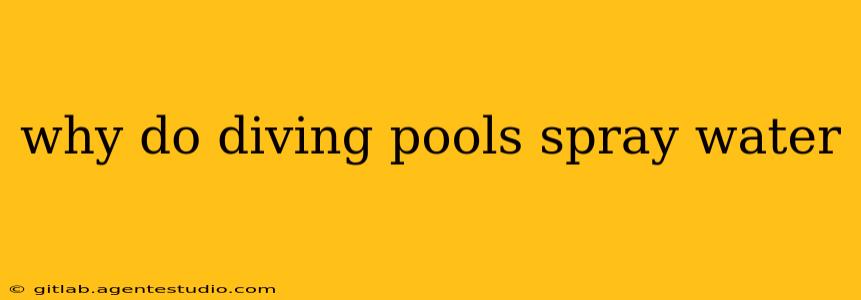Have you ever watched a diver plunge into a pool, only to be greeted by a spectacular spray of water? This isn't just a visually appealing byproduct; it's a crucial element of diving pool design related to physics, safety, and the overall experience. Let's dive into the reasons behind this watery spectacle.
The Science Behind the Spray
The primary reason diving pools spray water is due to the force of impact when a diver enters the water. Think of it like this: a diver, possessing significant momentum from their jump, displaces a large volume of water upon impact. This sudden displacement creates waves that propagate outwards, ultimately resulting in the spray we see.
Several factors influence the intensity of the spray:
- Diver's weight and speed: A heavier diver entering at a higher velocity will generate a more substantial splash and spray.
- Diving board height and angle: Higher diving boards and steeper entry angles contribute to increased impact force and greater spray.
- Water depth: While seemingly counterintuitive, shallower water can actually amplify the spray effect as the water has less space to absorb the impact energy.
- Water properties: Factors like water temperature and surface tension can subtly affect wave formation and spray characteristics.
More Than Just a Pretty Sight: The Role of Safety
Beyond aesthetics, the spray itself plays a subtle role in safety:
- Energy dissipation: The spray helps to dissipate some of the diver's kinetic energy upon impact, reducing the force experienced by the diver.
- Visible impact point: The spray makes the point of impact clearly visible to lifeguards and other observers, allowing for quicker assessment of the dive and any potential issues.
Pool Design and Spray Management
Diving pool designers carefully consider the potential for water spray when constructing these facilities. Certain elements are incorporated to manage and mitigate its effects:
- Strategic placement of diving boards: The location of diving boards is often chosen to minimize spray towards spectator areas or sensitive equipment.
- Pool depth and shape: Deeper pools and those with gently sloping bottoms help to absorb the impact and reduce spray.
- Deck design and barriers: Properly designed decks and splash barriers can protect spectators and equipment from the spray.
- Water filtration and recirculation: Efficient filtration systems are crucial to quickly clear away any debris or contaminants stirred up by the spray.
Beyond the Diving Board: Other Factors Contributing to Spray
While the diving board is the primary source, other factors can contribute to water spray in a diving pool:
- High-volume water features: Some diving pools incorporate waterfalls, fountains, or other water features that inherently create spray.
- Powerful wave machines: Pools featuring wave-generating systems will naturally produce significant spray.
- Improper maintenance: A poorly maintained pool with a clogged filtration system or other issues might experience excessive splashing and spraying.
Conclusion: A Symphony of Physics and Design
The spray from a diving pool is not merely a decorative feature. It's a complex phenomenon rooted in physics, inextricably linked to the safety and design considerations of the pool itself. Understanding the science behind the spray provides deeper appreciation for the engineering and planning that goes into creating a safe and enjoyable diving experience.

